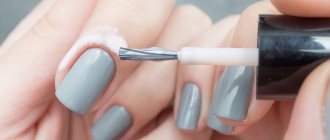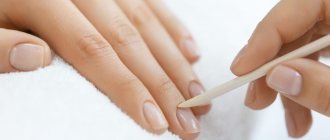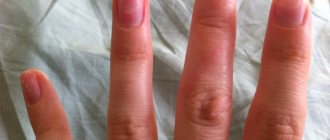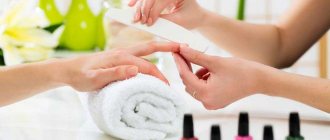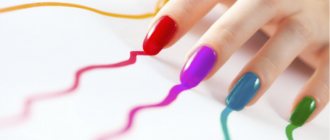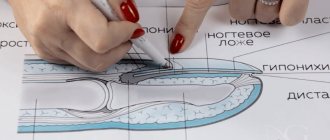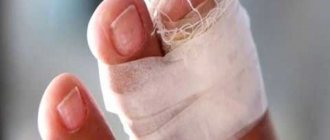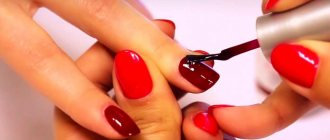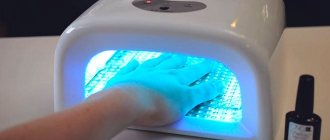Nail prosthetics is the replacement of a missing part of the nail plate or the strengthening of its injured area with artificial material. The procedure is of particular interest to women, as it eliminates a cosmetic defect. Returns hands or feet a beautiful, well-groomed appearance. Nail replacement is a temporary measure until a new healthy nail grows.
In what cases is it used?
Prosthetic nails on the fingers or toes solve aesthetic problems that arise from certain diseases or accidental injuries. Helps eliminate psychological discomfort, get rid of embarrassment and unnecessary questions from others.
Nail prosthetics are used for:
- onycholysis (separation of the nail plate from the bed);
- fungal infection (onychomycosis), if most of the plate had to be cleaned off;
- strengthening, additional stabilization of the nail plate during its delamination, fragility;
- loss of part of the nail as a result of injury;
- deformations of the nail plate (ingrowing, twisting, spoon-shaped);
- the need to overcome the distal nail fold (a condition when the skin in the area of the free edge becomes rough and it is difficult for the nail to cross this barrier for further growth in length).
The procedure is also used to protect the exposed part of the nail bed from injury, restore temporarily lost functions, and correct the direction of growth (prosthetics of an ingrown nail).
This protection is especially relevant for women's hands. For example, after cleaning the area affected by the fungus and removing part of the nail plate, the bed will be open. Since it contains many nerve endings, the stripping area will be very sensitive to any touch. You will need to carefully wash your hands, cook, change clothes, or do other household chores. Protecting the nail bed with artificial material will help remove unpleasant sensations, make it possible not to be afraid to perform simple actions, and not hide your hands from others.
Medical features of healthy nails
Being an appendage of the skin, the nail is a dense horny plate that well protects the underlying tissue of the nail bed from the effects of various environmental factors - mechanical, chemical, thermal, etc.
Like other epidermal formations, the nail develops from the end of 3 months. intrauterine period of life. First, a layer of peculiar cells is formed, from which the nail bed is subsequently formed, then the nail folds and the nail skin. The formation of the nail plates themselves occurs at 8 months. fetal development.
The nail plate in healthy people is smooth, colorless and largely transparent, therefore, due to the translucency of the superficially located numerous small vessels (capillaries) of the nail bed, it appears pink. A nail can change color due to various diseases, most often this occurs when infected with various microorganisms. Many microbes are capable of synthesizing various pigment substances and, as a result, can give the affected nail a variety of colors from ocher-yellow to dark green or black. However, we must not forget that the color of the nail can also change due to other non-infectious reasons, for example, diseases of the internal organs (often liver diseases).
During normal development, the nail plates are slightly convex, which to some extent helps protect the nail bed from impact, since its force is transmitted through the side parts of the plate to the soft tissue of the nail folds.
Anatomically, the following parts of the nail plate are distinguished: the anterior free edge, not attached to the nail bed, the body of the nail, two lateral edges and the root part of the nail, hidden under the nail. The back of the nail plate and the adjacent lateral areas are covered with nail folds. The part of the skin lying under the body of the nail is called the nail bed. The nail plate has two surfaces: a smooth, shiny outer surface and an uneven inner surface, forming horny protrusions directed into the depths of the underlying tissue. The outer plate can reveal to us some secrets about the person to whom it belongs; in nervous individuals, especially in the presence of itching or some kind of skin disease accompanied by itching, the plate, due to constant scratching, becomes shiny, polished, as if covered with varnish.
The nail plate fits tightly to the nail bed. Between it and the nail folds, nail grooves are formed, to the base of which the edges of the nail plate fit tightly on both sides. The posterior nail fold, covering the back of the nail plate, passes into a thin horny border - the nail skin, or cuticle (in medicine, the term eponychium is used to refer to the cuticle, which is translated as epo - above, onikh - nail, the skin above the nail is obtained). The latter fits tightly to the surface of the nail plate and blocks access to the nail root. The area of the nail plate located closer to the back fold has a matte color and a crescent shape. It is called the nail hole. The lunula, as a rule, is well defined on the thumb and index finger and is less common on the remaining fingers of the hand. There has long been debate in medicine about how this lunula is formed. Apparently, in the area of the lunula, the nail plate is not so transparent due to the inclusion in the horny structures of the remains of organelles and nuclei of those cells that form the nail.
The root of the nail, which also has the shape of a lunula, is equipped, especially in its central part, with horny protrusions arranged in the form of small teeth. Towards the free edge, the denticles are connected to each other and form longitudinal lines passing through the entire inner surface of the nail plate. Due to these projections, denticles and ridges, the nail raft is attached to the nail bed. However, in many pathological situations, these denticles are destroyed or torn away from the nail bed, resulting in detachment of the nail plate - onycholysis (onycho-nail, lysis-splitting, destruction). To help you understand how the nail attaches to the nail bed, you can imagine a Velcro shoe lock. On one side of the Velcro there are dense hooks, and on the other side there are soft elastic fibers, to which the hooks cling when closing the Velcro lock. Also, the nail plate clings to the nail bed due to the protrusions. Where the nail plate emerges from the nail bed, between the free nail edge and the outer surface of the fingertip, an open anterior gap is formed, which is called the subungual notch; this is where fungal infection of the nails most often begins to develop - onychomycosis (onycho - nail, mycosis - fungus)
One of the unsolved questions is the formation of nail plates. It is believed that the nail is formed from special cells - onychoblasts. These cells are located in the nail matrix area and in the nail bed area, and in the matrix area there are much more of these cells and they are larger. Due to the onychoblasts of the matrix, the nail grows in length, and due to the onychoblasts of the nail bed, in thickness. The matrix plays the most important role in the formation and development of the nail plate. When the matrix is injured, during inflammatory processes or when blood circulation in the matrix is impaired, the formation of the nail plate is disrupted, up to the complete absence of the nail - anonychia (an - absence, onych-nail).
The nail plate contains a huge number of different substances and elements. Scientists have found that the nail plate consists of 50.3-51.9% carbon, 6.4-7.0% hydrogen, 16.2-17.7% nitrogen, 20-25% oxygen, 20-25% sulfur. 0.7-5.0%
There is also water in nails, and the amount of water in nails in summer is 30% more than in winter. The amount of fat in nails ranges from 0.15 to 0.76%. Of the fat-like substances, cholesterol and its esters are found in small quantities. As for minerals, nails contain calcium phosphates, phosphorus, carbonates, iron, magnesium and other substances. It is interesting to note that the amount of arsenic in nails is the highest of all organs and tissues of the body.
Since ancient times, scientists have carefully monitored the growth rate of nails. Attempts to observe the rate of nail growth date back to the 17th century, when for this purpose they used a kind of marking of nail plates with metal salts, especially gold and silver.
In addition to artificial marks on the nail plate, you can use natural ones for these purposes - transverse grooves, white stripes or leukonychia (leuko - white, onikh - nail). Thus, it is possible to determine the period (prescription) of damage to the matrix by the influence of endogenous and exogenous factors from the stigmas present on the nails, and this is of practical importance for doctors.
With an average growth rate of 0.1 mm per day and an average length of the visible part of the nail equal to an average of 12.8 mm, the growth time of fingernails is 128 days. The time for complete regeneration of the nail plate should not be mixed with this time of movement. The regeneration time is longer, since part of the nail is located under the posterior nail fold. This so-called latent time corresponds to a length of 3 - 4 mm and is 30 - 40 days, maybe longer. So, a complete nail renewal takes about 170 days on average. On the foot, nails grow much more slowly, on average for a year and a half, and therefore the fungus more often affects the toenails. The growth rate of nails varies depending on age, diseases, time of year, and whether the nail belongs to a particular finger. Still, as noted above, on average it is 0.1 mm per day, and the regeneration time is 6 months, but individual fluctuations vary significantly.
In research, some scientists have discovered differences in the growth rate of nail plates depending on gender and specific fingers. Women's nails grow slightly slower than men's (on average 0.004 mm less). Children's nails grow faster than those of adults, so nail fungus is practically not observed in children; the fungus simply does not have time to penetrate the nail plate.
There are differences in the growth rate of nail plates on different hands and different fingers and (according to the growth rate) they can be arranged in the following sequence; III, II, IV, I, V. The nails on the right hand grow slightly faster than on the left. At different periods of life, nails grow at different rates, as has been established, fingernails; from birth to 5 years they grow at an average rate of 0.06 - 0.08 mm per day; 5 – 30 years – 0.1–0.14 mm; 30–60 years -0.07-0.1 mm; 60–85 years – 0.04–0.07 mm. Acceleration of nail growth can be observed during pregnancy. It disappears immediately after childbirth. The rate of nail growth is greatly influenced by the state of blood circulation. In people with impaired blood circulation, nails grow more slowly, the nail plates become dystrophic and a fungal infection easily attaches to them, so people with varicose veins and other vascular diseases are at risk for onychomycosis. Numerous studies indicate fluctuations in the growth rate of nail plates depending on the time of year. In winter, nails grow slower than in summer by 8-13%. This applies to all age groups. It is also noted that nail diseases and general diseases both directly and indirectly affect the rate of nail growth. Severe general diseases can cause complete cessation of nail growth in a short time.
Some quantitative data are of more educational than practical interest: in 1893, one German scientist carefully collected clippings of his own nails for 7 months. Their weight after drying was 1.56 g.
Here is such a long and interesting history of such small appendages of the skin of our body!
Benefits of nail prosthetics
To do or not to do the procedure? Before answering this question, you need to get acquainted with its advantages. According to reviews, after prosthetics, artificial nails in appearance are almost no different from natural ones. They can be varnished, decorated with rhinestones and other decorative elements. They look natural and are comfortable to wear.
The prosthesis does not weigh down the plate and has good flexibility. Promotes the growth of smooth, strong nails. When installed on the toes, it does not cause problems with walking, as it is capable of shock absorption.
Nail prosthetics are safe, quick and painless. Prevents damage to soft tissues, protects the nail bed from injury, stress, and preserves tactile sensations. When using materials with fungicidal components, it reliably protects against fungal infection.
How long does a nail grow after removal: approximate forecasts
Many patients want to know how long the nail grows after removal. There are many reasons for this. The finger must be covered with a breathable antibacterial patch. Of course, injuries also affect how long a nail grows after removal. You should try to avoid them. It takes 2-3 weeks for complete healing, but about 3-4 months for a new nail to grow.
We recommend: Zalain cream as a remedy against nail fungus
Often, during surgery, the growth area of the nail plate is damaged, which ultimately leads to an irregular shape of the growing nail.
Nail prosthetics and extensions
Are prosthetic nails and acrylic or gel extensions for decorative purposes the same thing? No. In fact, these are completely different procedures in purpose and technique. How are they different?
Firstly, different materials are used. Coverings for extensions are too hard and can seriously injure the damaged nail plate and nail bed during stress. Therefore, medical gels containing plasticizers are used for nail prosthetics. They give the artificial material both strength and flexibility. Sometimes coatings are needed that contain substances that are active against fungi and have medicinal properties. Experts often use German gels. They are available in three colors - opal, pink and transparent. You can apply them directly from the tube.
Secondly, the methodology for performing the procedures is different. Unlike gel or acrylic extensions, not every master can do prosthetic nails. Special knowledge and 100% sterility are extremely important here. Disposable materials and sterile instruments are used. This rule is strictly observed in our podiatry center in Moscow when prosthetizing fingernails or toenails.
Preparation
The preparatory stage has a certain sequence:
- Wash your hands with soap.
- Treat the instruments (even if the pedicure set is intended for individual use only).
- If you need to trim fungal nail plates, you must wear gloves.
- Wash your feet before trimming.
- If the plates are brittle, it is advisable to soften the plate with a warm bath before starting.
The bath will help soften your nails, prevent the formation of cracks, and simplify the process of cutting.
Foot bath
Tool processing
For these purposes, it is necessary to use a soap solution and disinfectants. Metal objects must be immersed in a disinfectant solution for at least 10 minutes. Then rinse and dry. An oven can be used as a sterilizer.
Tool processing
This completes the preparatory stage. Before you begin, it is worth studying the step-by-step instructions for implementation.
How is it done?
Gel nail prosthetics on the hands or feet is carried out in one session after treating inflammatory processes, if any. The tight fit to the nail bed and the softness of the gel allows you to completely imitate a natural plate.
The procedure consists of the following steps:
- Preparation of the nail plate, removal of the damaged part, polishing, antiseptic treatment, degreasing.
- Applying a thin layer of special gel for nail prosthetics.
- Polymerization, hardening of the gel under a UV lamp.
- Apply another 1 - 2 layers of gel in the same way.
- Formation of a free edge of white color.
- Shape correction, polishing.
What a nail looks like after prosthetics is shown in the photo on the Internet.
In addition to the above, there are other methods. For example, when the prosthesis is made in advance from an impression or when the nail is formed by layer-by-layer application of glue and copoline (breathable material on a non-woven base). To better understand how they differ, watch the different types of nail prosthetics in a YouTube video. Which method is best is determined by a specialist depending on the cause of onycholysis and the severity of the initial condition.
In case of fungus, nail prosthetics are allowed only after completion of the course of treatment. If you apply artificial coating earlier, this may result in complete destruction of your own nail plate, worsening the situation. The fact is that when modeling is done on the nail bed on the feet, unlike on the hands, there is no free edge. The prosthesis fits tightly to the bed, oxygen does not get under it. At the same time, moisture continues to be released from the bed, and if there are remnants of any infection in a closed, damp space, very favorable conditions are created for its development. After treatment of onychomycosis, prosthetic nail gels with clotrimazole, triclosan or other substances active against fungi are used.
How a new plate grows after injury
If the nail has moved away from the skin due to the blow, then you need to act quickly. After receiving a bruise, you should relieve the pain by applying cold, for this you need to apply ice to your finger for 3-4 minutes, then repeat the steps again. This will help the hematoma resolve. Then you should treat the surface with hydrogen peroxide. After this, severe rejection of the plate will begin, which can be prevented by gluing an adhesive plaster or applying a pressure bandage. These actions can help: the plate will not be completely torn off and will be able to adhere to the skin. The cause of rejection is hemorrhage: the plate will rise and peel off.
If the nail is completely peeled off, a new plate begins to grow. But there are times when the nail tears and does not grow even after a month, this is due to the fact that the growth zone of the nail is damaged. In this situation, you need to contact a specialist for advice.
How a new nail grows after an injury depends on its nature. The deformation of the plate is caused by the inflammatory process, but then a smooth plate begins to grow.
After care
After nail prosthetics, supervision by a podologist is required. The artificial material is worn until the healthy nail grows completely. This can take anywhere from 1 month to a year depending on the rate of growth of the plate and how much of it was lost initially. During this time, the prosthesis is corrected or replaced every 1 to 2 months.
When wearing artificial material, a gentle regime is indicated, protection from excessive loads. When getting prosthetic toenails after fungus or injury, you should temporarily avoid playing sports. They increase the load and pressure on the toes (dancing, football). And also avoid shoes with narrowed toes, as this will lead to deformation of the prosthesis and increase the treatment time.
After prosthetic nail replacement, it is very important not to allow it to touch, because in this case it will come off along with the natural nail. It is necessary to use medications at home daily, which are recommended by a specialist. It is important to treat your finger with antiseptics. To improve blood circulation and nutrition in the damaged nail bed, it is recommended to do a light massage daily at the base of the nail plate.
What to do to speed up the healing process?
In case of a nail injury, doctors recommend:
- Cold compresses. Cooling will help relieve pain, reduce swelling and stop bleeding. On the day you are injured, apply ice to the wound every two hours. For convenience, place ice cubes in a bag and wrap them in a towel. Apply cold compresses 3-4 times a day throughout the following days.
- Keep the injured limb elevated. Especially if the finger is swollen. Try to keep your hand above the level of your heart, placing it on a table or pillow. If your toe is injured, take a horizontal position more often and stretch your leg onto a pillow or armrest.
- Refrain from wearing tight shoes. If possible, wear only soft, loose shoes that will not put pressure on the injured toe. Walk around the house barefoot or in slippers until the toe is completely healed.
- Take over-the-counter pain relievers. Ibuprofen, Nurofen or Naproxen are perfect for this purpose: they reduce swelling and relieve pain. If the injured finger does not swell, you can take Acetaminophen.
Note! The fact that drugs are dispensed without a prescription does not mean that they can be taken uncontrolled. Make sure in advance that you have no contraindications for use and consult your doctor.
On average, a nail grows completely in six months to a year. You will have to be patient and make every effort to ensure that the new nail plate takes its “rightful” place.
A torn nail on the little finger or other finger is a fairly common situation, and there is no need to be alarmed. Timely treatment and consultation with a doctor will help you quickly solve the problem and return to your normal lifestyle without pain and discomfort.
When not to do it?
The procedure cannot be done if there are open wounds, an inflammatory or purulent process, or an acute fungal infection in the treated area. In case of a fungal infection, using hardware stripping, creams, medicinal varnishes, sprays containing components active against the fungus, the pathogen is first destroyed. Limitations for the procedure also include the complete absence of a nail plate.
For safe nail prosthetics, contact podiatry centers, as this is a rather serious medical procedure. It can be performed by a specialist who has undergone appropriate training. Entrusting this to an ordinary manicurist or pedicurist is dangerous. Especially if there is parallel onychomycosis, ingrowth, and diabetes mellitus. Correctly provided assistance will return your hands and feet to their beauty and neat appearance, and eliminate the fear of wearing open shoes or going to the beach or pool.
You can make an appointment at the Eva Korneeva Podology Center in Moscow for nail prosthetics and find out prices by calling +7 (985) 489-45-86.
0 0
Step-by-step instruction
It is not recommended to cut your hair in one motion. You need to trim your nails gradually, that is, in several stages. You need to give your nails a shape using a nail file.
- Place a towel or napkin on the floor. This will help you later collect all the clipped nails and throw them away.
- The cut must be made in several stages, without going deep to the ends of the plate. You should not try to trim ingrown toenails in one motion at once, as this may cause separation or damage to nearby tissues.
- It is not recommended to cut the plate at the root. This will cause damage to soft tissues and can cause infection and pain. The strip should always remain a small width.
- Use a nail file to give the desired shape. A buff might also work. There is no need to frequently cut dry-trimmed nails, as they will begin to flake. They can be of various shapes: round, oval, or even rectangular. The form should not have pointed areas. They need to be filed from the edges to the central part.
- Dry your feet with a towel or disposable towel.
- Lubricate your feet with moisturizer, oil, or wax. This will save the skin from drying out and splitting the nail plates.
Before cutting a nail affected by fungus, you need to apply an antifungal cream or gel to it. If you need to trim ingrown toenails, you can rub in a softening or anti-inflammatory cream.
Features of toenail treatment
Tools
- Pedicure nippers , allowing not only to shorten the nail plate, but also to trim off hangnails and keratinized side ridges;
- rounded and straight nail scissors , allowing you to work on the length and shape of the nail plate;
- special pedicure file ;
- separators for fingers, allowing you to handle each of them with greater convenience;
- pumice for rough skin;
- cosmetics for treating the skin of the feet and nail plate.
Pedicure tools
Preparing nails for the procedure
Before a trimmed pedicure, it is best to steam your feet in a warm bath with oils or special cosmetics.
Foot bath before pedicure
First of all, it will moisturize the skin so that it will be easy to process, and in addition, it will soften the nails and cutting them will be painless.
Also, any procedure for treating feet should begin with their complete disinfection: first, any dirt must be wiped off with a rough brush, and then treated with any suitable disinfectant.
Leg cutting technique
When cutting your nails, you should not get too close to the pink part , but leave a small supply of regrown nail plate.
When cutting nails, the clipper should be held at right angles to the nail plate.
Making thick nails into a round shape using scissors or nippers can be dangerous, so they are cut at a right angle, and the sharp corners formed during the cutting process are filed down .
If your nail curls, you can try not cutting its length, but regularly shortening it with a nail file. In this case, after several procedures, the nails will noticeably straighten.
To avoid ingrown toenails, do not try to give your nails a square shape.
Experienced pedicure masters have a lot of their own professional secrets and techniques, which can greatly simplify the process and improve the quality of your home pedicure. Watch this video for a master class on trimmed mechanical pedicure:
Shortening toenails in a hardware pedicure
Hardware pedicure is a set of very simple and absolutely safe procedures for caring for the entire foot. It allows you to shorten the length of your nails and maintain a healthy “after-salon” appearance at home.
Hardware pedicure
This procedure begins with disinfection of the feet, after which, using a special round file attachment, gradually removed , which in the process are slightly rounded to the corners.
Then, using another cone attachment , the rough skin is removed . It is important to remember that a special cosmetic product is used to soften it, since it is better not to steam your feet before a hardware pedicure.
When changing attachments, it is important to treat the skin of the sole, between the toes, directly around the nails and in places where calluses form. Particular attention is paid to the treatment of cuticles.
At first, hardware nail treatment raises a lot of questions and doubts for a novice fashionista; this video tutorial shows in detail the entire pedicure process performed with a pedicure machine:

